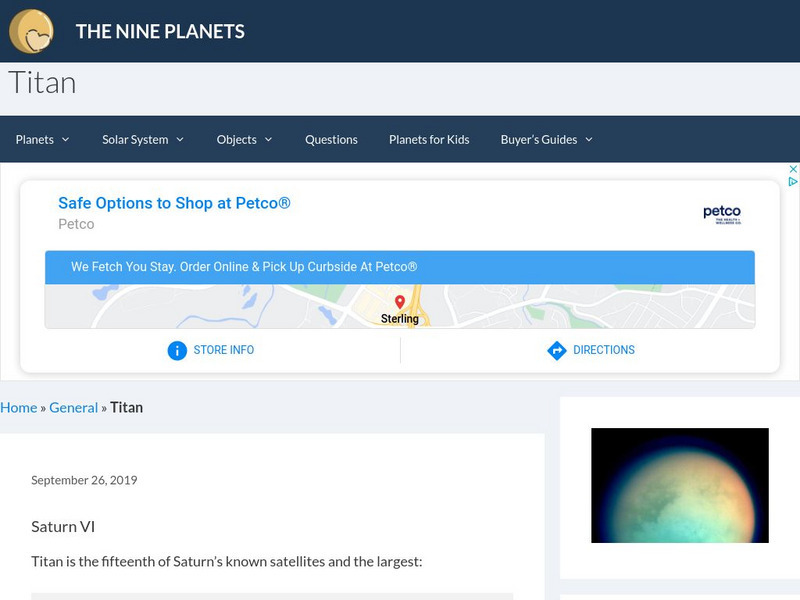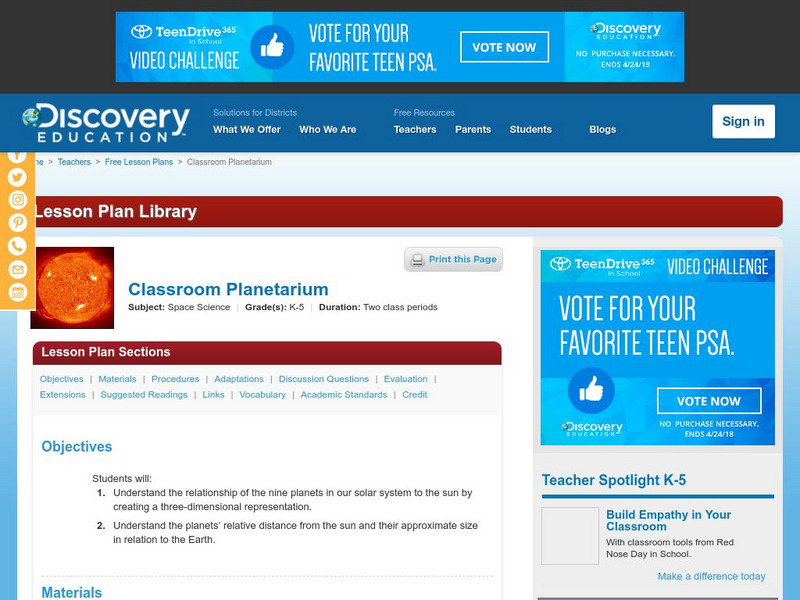Hi, what do you want to do?
TeachEngineering
Teach Engineering: An Inflated Impression of Mars
The purpose of this activity is to use scaling in order to give students an idea of the size of Mars in relation to the Earth and the Moon as well as the distance between them. The students will have to calculate dimensions of the scaled...
Math Planet
Math Planet: Pre Algebra: Measure Areas
Demonstrates how to calculate the area of two-dimensional shapes using formulas. Covers parallelogram, triangle, trapezoid, and circle. Includes a video modeling how to find the area of a circle and a triangle. [0:59]
Alabama Learning Exchange
Alex: Protect Our Planet Piece by Piece
In this lesson from "The Friends of Auntie Litter", (www.auntielitter.org), food webs and their significance will be explored. This lesson is one from the "Take Pride Statewide" series. *Lesson provided by Julie Danley and Pam Walston.
University of California
Uc Berkeley: At Home Astronomy: The Size and Distance of Planets
In this activity, "You will investigate the concepts of relative size and distance by creating a basic model of our solar system." Planet printouts are provided and this site contains related links.
Other
The Ptolemaic Model of the Planetary System
An easy-to-read description and history of Ptolemy's geocentric model of the universe. Geocentric means that Ptolemy believed the Earth was the center of the universe.
National Geographic
National Geographic: Planetary Size and Distance Comparison
Students review the sizes of planets and their order relative to the Sun. They then learn about astronomical uses and create a model of the solar system that reflects planetary distances. Includes handouts and worksheets as well as a...
Other
Sunaeon: Solar System Scope
Experience the solar system as you've never seen it before; up close and personal. Visit each planet by clicking on it, then selecting the play button to track its rotations through the calendar year. Watch the constellations move...
Science Buddies
Science Buddies: Pop Goes the Geyser!
Our home, Earth, is a living planet. Earthquakes and volcanic eruptions are proof that the geological forces that shaped our planet and created the land masses are ongoing. An amazing example of geologic activity that is less damaging is...
Purdue University
Purdue University: 3 D Earth Structure Model
Take a journey to the center of the Earth and learn about the structure, material properties, and conditions inside our planet.
TeachEngineering
Teach Engineering: Spacecraft Design: Beat the Heat
To understand the challenges of satellite construction, student teams design and create model spacecraft to protect vital components from the harsh conditions found on Mercury and Venus. They use slices of butter in plastic eggs to...
Other
Paper Plate Education: Serving the Universe on a Paper Plate
Excellent resource for "paper-plate" activities that help simplify various astronomy topics. Learn how to build a "Moon Finder" and "Planet Pointer," and create a paper-plate model that explains the Transit of Venus.
ClassFlow
Class Flow: Modeling and Solving Equations
[Free Registration/Login Required] The objectives of this flipchart are to show students how to solve one-step equations and use equations to solve real-world problems.
ClassFlow
Class Flow: The Powers of Writing
[Free Registration/Login Required] This resource outlines and defines the POWERS model for good writing.
ClassFlow
Class Flow: Fitting Models to Data
[Free Registration/Login Required] A basic premise of science is that much of the physical world can be described mathematically and many physical phenomena are predictable. This scientific outlook took place in Europe during the late...
ClassFlow
Class Flow: Linear Models
[Free Registration/Login Required] Students will learn the different forms of an equation of a line and will find the equations of a line in all three forms- point-slope form, slope-intercept form, and the general form (Ax+By=C).
ClassFlow
Class Flow: Filling in the Number Line
[Free Registration/Login Required] In this flipchart students can practice their counting skills. The teacher can model first filling in the empty spaces on the number line with the pen tool. After modeling you can clear the pages with...
Other
Nine planets.org: Ptolemy
This site from the University of Arizona provides a background of Ptolemy's profound influence in the areas of astronomy, geography, and cartography. Includes good pictures and related links.
ClassFlow
Class Flow: The Napping House
[Free Registration/Login Required] Flipchart aligned with the story - The Napping House.
Science Education Resource Center at Carleton College
Serc: Creating the Solar System
This two-part lesson begins with a lecture which describes the complex process of creation from molecular cloud to planetesimals to planets to organized solar system. The lecture is followed up with a draw/write activity in which the...
South Carolina Educational Television
Know It All: Solar System Simulation
Fourth graders will begin to understand the solar system by using and creating models to demonstrate the layout of the solar System.
Nine Planets
The Nine Planets: Titan
This site from The Eight Planets shows that Titan may serve as a model of a highly reduced early Earth atmosphere in which the first stages of organic chemical evolution could take place in the atmosphere.
TeachEngineering
Teach Engineering: Air Pollution
Students are introduced to the concept of air quality by investigating the composition, properties, atmospheric layers and everyday importance of air. They explore the sources and effects of visible and invisible air pollution. By...
Discovery Education
Discovery Education: Classroom Planetarium
Create a classroom model of the solar system while teaching about relative size of all the planets, and each planet's distance from the sun.
ClassFlow
Class Flow: Poetry
[Free Registration/Login Required] This flipchart models the poetry of Cinquains (winter).



























